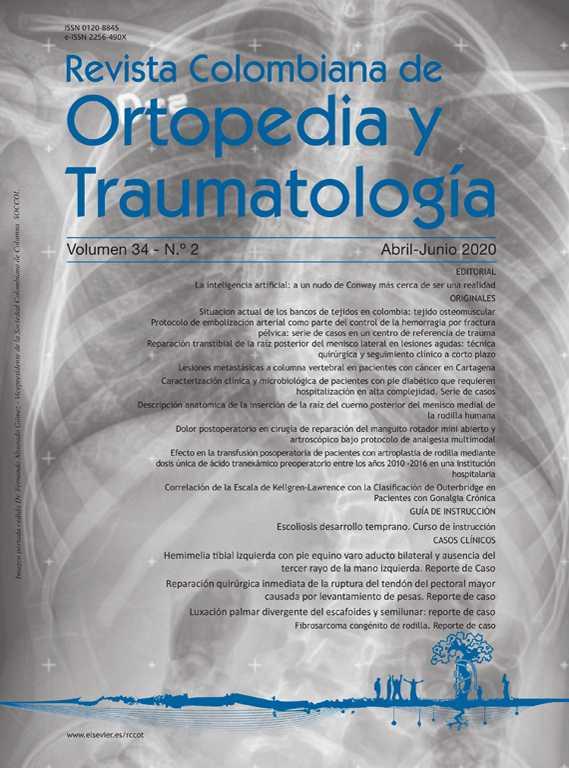Hemimelia tibial izquierda con pie equino varo aducto bilateral y ausencia del tercer rayo de la mano izquierda. Reporte de Caso
DOI:
https://doi.org/10.1016/j.rccot.2020.06.008Palabras clave:
hueso, anormalidades del desarrollo, hemimelia tibial, pie equinovaroResumen
La hemimelia tibial se puede presentar en una gran variedad de espectros, desde la hipoplasia tibial hasta la ausencia completa de la tibia con o sin compromiso adjunto cuadricipital, ligamentario, patelar, fibular y/o femoral; esto ha dado lugar a múltiples clasificaciones con implicaciones anatómicas y terapéuticas. Esta enfermedad se ha descrito desde 1841, sin embargo, es la deficiencia más rara en las extremidades inferiores, siendo la más común la deficiencia fibular.
Presentamos un paciente con diagnóstico antenatal de pie equino varo bilateral, agenesia de la tibia izquierda y comunicación aurículo ventricular (CIA) con cariotipo normal. Al nacer presenta fascies normales. Se confirma con radiografías la ausencia del tercer rayo de la mano izquierda y la ausencia de la tibia izquierda con ensanchamiento del peroné, tipo 5C en la clasificación de Paley, y pie equino varo aducto bilateral.
Nivel de Evidencia: IV
Descargas
Referencias bibliográficas
Clinton R, Birch JG. Congenital Tibial Deficiency: A 37-Year Experience at 1 Institution. J Pediatr Orthop. 2015;35:385-90. https://doi.org/10.1097/BPO.0000000000000280
Paley D. Tibial hemimelia: new classification and reconstructive options. J Child Orthop. 2016;10:529-55. https://doi.org/10.1007/s11832-016-0785-x
Weber M, Schröder S, Berdel P, et al. Register zur bundesweiten Erfassung angeborener Gliedmaßenfehlbildungen [Database for the nationwide collection of congenital limb malformations]. Z Orthop. 2005;143:1-5. https://doi.org/10.1055/s-2005-872467
Chinnakkannan S, et al. A case of bilateral tibial hemimelia type VIIa Indian Journal of Human Genetics. 2013:108-10. https://doi.org/10.4103/0971-6866.112924
Jayakumar SS, Eilert RE. Fibular transfer for congenital absence of the tibia. Clin Orthop Res. 1979;139:97-101. https://doi.org/10.1097/00003086-197903000-00016
Sowinska-Seidler' A, Socha M, Jamsheer A. Split-hand/foot malformation - molecular cause and implications in genetic counseling. J Appl Genet. 2014;55:105-15. https://doi.org/10.1007/s13353-013-0178-5
Hesselschwerdt HJ1, Heisel J. Mesomelic dysplasia: presentation of a case and literature of Werner's syndrome. Z Orthop Ihre Grenzgeb. 1990;128:466-72. https://doi.org/10.1055/s-2008-1039598
Wiedemann HR, Opitz JM:. Unilateral partial tibia defect with preaxial polydactyly, general micromelia polydactylyandtrigonomacrocephaly with a note on "developmental resistance". Am J Med Genet. 1983;14:467-72. https://doi.org/10.1002/ajmg.1320140310
Carvalho DR1, Santos SC, Oliveira MD, Speck-Martins CE. Tibial hemimelia in Langer-Giedion syndrome with 8q23.1-q24 12 interstitial deletion. Am J. Med Genet A. 2011;155A:2784-7. https://doi.org/10.1002/ajmg.a.34233
Richieri-Costa A, Ferrareto I, Masiero D, et al. Tibial hemimelia: report on 37 new cases, clinical and genetic considerations. Am J Med Genet. 1987;27:867-84. https://doi.org/10.1002/ajmg.1320270414
McKay M, Clarren SK, Zorn R. Isolated tibial hemimelia in sibs: an autosomal-recessive disorder? Am J Med Genet. 1984;17: 603-7. https://doi.org/10.1002/ajmg.1320170308
Deimling S, Sotiropoulos C, Lau K, et al. Tibial hemimelia associated with GLI3 truncation. J Hum Genet. 2016;61:443-6. https://doi.org/10.1038/jhg.2015.161
McCredie J, Willert HG. Longitudinal limb deficiencies and the sclerotomes An analysis of 378 dysmelic malformations induced by thalidomide. J Bone Joint Surg (Br). 1999;81:9-23. https://doi.org/10.1302/0301-620X.81B1.0810009
American Institute of Ultrasound in Medicine. AIUM Practice Guideline for the Performance of an Antepartum Obstetric Ultrasound Examination. Laurel, MD: American Institute of Ultrasound in Medicine; 2003.
Goldstein I, Lockwood C, Belanger K, Hobbins J. Ultrasonographic assessment of gestational age with the distal femoral and proximal tibial ossification centers in the third trimester. American Journal of Obstetrics and Gynecology. 1988;158:127-30, http://dx.doi.org/10.1016/0002-9378(88)90793-4. https://doi.org/10.1016/0002-9378(88)90793-4
Serman LS, Potter SS, Scott WJ. En: Larsen WJ, editor. Human embryology. 3rd ed New York: Churchill Livingstone; 2002. p. 315-28.
Jones D, Barnes J, Lloyd-Roberts GC. Congenital aplasia and dysplasia of the tibia with intact fibula: classification and management. J Bone Joint Surg (Br). 1978;60:31-9. https://doi.org/10.1302/0301-620X.60B1.627576
Weber M. New classification and score for tibial hemimelia. J Child Orthop. 2008;2:169-75, http://dx.doi. org/10.1007/s11832-008-0081-5. https://doi.org/10.1007/s11832-008-0081-5
Paley D, Chong DY Tibial hemimelia. In: Sabharwal S (1ed) Pediatric lower limb deformities: principles and techniques of management. Springer, Switzerland, pp 455-481. https://doi.org/10.1007/978-3-319-17097-8_24
Granite G, Herzenberg JE, Wade R. Rare case of tibial hemimelia, preaxial polydactyly, and club foot. World J Clin Cases. 2016;4:401-8. https://doi.org/10.12998/wjcc.v4.i12.401
Al Kaissi A, Ganger R, Rötzer KM, Klaushofer K, Grill F. A child with split-hand/foot associated with tibial hemimelia (SHFLD syndrome) and thrombocytopenia maps chromosome region 17p13.3. Am J Med Genet A. 2014;164A:2338-43, 10.1002/ajmg.a. 4 3661. https://doi.org/10.1002/ajmg.a.36614
Spiegel DA, Loder RT, Crandall RC. Congenital longitudinal deficiency of the tibia. Int Orthop. 2003;27:338-42. https://doi.org/10.1007/s00264-003-0490-5









